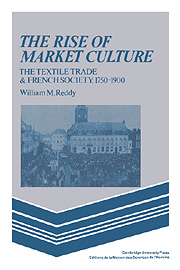Book contents
- Frontmatter
- Contents
- List of figures and maps
- List of abbreviations
- Preface
- Introduction
- Part One A world without entrepreneurs, 1750–1815
- Part Two Uses of the market idea, 1816–1851
- 4 The first crisis of management
- 5 Spinners on guard
- 6 Visions of subsistence
- 7 A search for identity
- Part Three Unquestioned assumptions, 1852–1904
- Conclusion
- Notes
- Bibliographical note
- Index
6 - Visions of subsistence
from Part Two - Uses of the market idea, 1816–1851
Published online by Cambridge University Press: 30 September 2009
- Frontmatter
- Contents
- List of figures and maps
- List of abbreviations
- Preface
- Introduction
- Part One A world without entrepreneurs, 1750–1815
- Part Two Uses of the market idea, 1816–1851
- 4 The first crisis of management
- 5 Spinners on guard
- 6 Visions of subsistence
- 7 A search for identity
- Part Three Unquestioned assumptions, 1852–1904
- Conclusion
- Notes
- Bibliographical note
- Index
Summary
By 1834, the fledgling French textile industry had made only a few fumbling steps toward treating labor consistently as a commodity independent of its products. With rare exceptions the control strategies prevalent in the industry maintained a partial independence for laborers, both in the spinning mills and in the putting–out networks of the countryside – a partial independence to which the laborers demonstrated a tenacious commitment. At the same time, any attempt to voice demands or grievances was considered by owners and government alike to be flagrant insubordination. Actual bargaining, whether collective or individual, was virtually unknown. Nonetheless in the years following the revolution of 1831, the textile laborer was suddenly made to stand before the rest of French society as the essential proletarian. In a flood of newspaper stories, speeches, government inquiries, and private investigative reports, he was portrayed, odd as it may seem, as the being who more than any other exemplified the fate of the wage laborer in a competitive market economy. Down to the present day the textile laborer of the early industrial revolution has continued to play this role on the stage of history, and any fact that might have gainsaid this view of him has been systematically ignored.
A BASE LINE OF COMPARISON
By 1830, there was a need for some group in society to play the role. In the new social order the possibility of advancement was balanced by insecurity. If rank was based solely on merit, it was as easy to move down as to move up.
- Type
- Chapter
- Information
- The Rise of Market CultureThe Textile Trade and French Society, 1750–1900, pp. 138 - 184Publisher: Cambridge University PressPrint publication year: 1984



